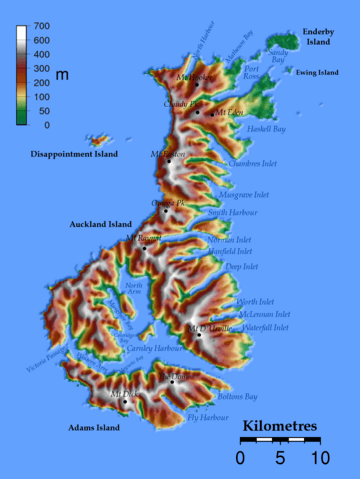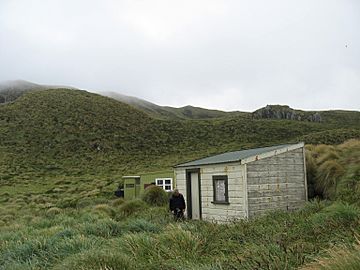Castaway depot facts for kids
A castaway depot is like a survival kit placed on a lonely island. It's a small hut or store filled with emergency supplies. These depots were made to help people who got shipwrecked or stranded far from home.
The New Zealand government built many of these depots on their remote subantarctic islands. This happened in the late 1800s and early 1900s. They kept these depots stocked and checked them regularly. Eventually, with new technology like radios and different shipping routes, these depots were no longer needed.
Contents
Dangerous Ocean Journeys
Long ago, many ships sailed between Australia, New Zealand, and Europe. They often used a route in the Southern Ocean called the "Clipper Route". Ships would go far south, into an area known as the Roaring Forties. This was to catch strong westerly winds that helped them sail around Cape Horn.
These winds were very powerful, and the waters were often rough and dangerous. Also, the maps of the islands in this area were not always correct. For example, in 1868, a ship captain named Henry Armstrong found that the Auckland Islands were actually 35 miles (56 km) north of where the maps showed them.
The weather was often cloudy, making it hard for sailors to use their tools to find their way. The uninhabited Auckland Islands were right in the middle of this busy shipping route. If a ship crashed on these islands, survivors would find very little food or shelter. Thomas Musgrave, a captain shipwrecked there in 1864, described the weather as "constant hail, snow and pelting rain."
In 1864, the ship Grafton crashed on the Auckland Islands. Five survivors lived in huts for 19 months. Three of them eventually sailed to Stewart Island / Rakiura in a repaired boat to get help. In the same year, another ship, the Invercauld, was also wrecked there. Out of 25 crew members, 19 made it to shore, but only three survived the winter. They didn't know the Grafton crew was nearby.
Then, in 1866, the General Grant was wrecked. Only 10 out of 83 people survived on the island for 18 months. These terrible events showed how important it was to have a plan for castaways. This led to the creation of the castaway depots.
Setting Up Rescue Stations
After the General Grant survivors were found in 1867, the New Zealand government decided to act. They set up emergency depots on islands like Auckland, Campbell, Antipodes, and Bounty Islands. The first trip to build these depots was in 1868. The very first wooden depot was built on Enderby Island.
From 1877 to 1927, government steamers like the NZGSS Hinemoa regularly visited the islands. They checked for survivors and kept the depots in good shape. These ships visited every six months. They repaired huts, chopped firewood, and even released live animals onto the islands. This was so castaways would have food. These patrols also helped scientists explore the islands.
Around 1927, the patrols and depot maintenance stopped. This was because radio technology improved, and ships no longer used the dangerous southern route as much.
What Was Inside the Depots?
The curse of the widow and fatherless light upon the man that breaks open this box, whilst he has a ship at his back.
The government workers built these supply depots in different sizes and designs. They were filled with emergency food like canned meat and biscuits. They also had warm clothes, blankets, fishing gear, medicine, matches, and tools. Even weapons and ammunition were included so people could hunt for food. The clothes were specially made to be warm and strong.
"Finger posts" or signposts were put up on the islands to guide castaways to the huts.
Animals were also released onto the islands to provide food. Pigs were put on the Auckland Islands in the early 1800s. Later, goats were released on Auckland, Enderby, Ewing, and Ocean Island. Sheep and rabbits were also introduced. Some of these animals died, but others survived for many years.
Today, some of these animal populations are rare. The Department of Conservation has moved some of them to mainland New Zealand. This helps protect these unique breeds and allows the subantarctic islands to return to their natural state.
Some islands also had boatsheds. These allowed survivors to reach other islands or nearby depots. For example, a boatshed on Enderby Island helped people get to the main Auckland Island. The survivors of the Derry Castle shipwreck in 1887 even built a small boat called a punt to travel between islands. This punt is now on display at the Southland Museum and Art Gallery.
Sadly, some depots were robbed by whalers and other sailors. They saw the depots as a source of free supplies. To stop this, clothing in the depots was specially marked. Warnings were also painted on the huts.
Where Were the Depots?
On the Auckland Islands, depots were found at Norman Inlet and Erebus Cove. Erebus Cove also had a boatshed. Today, the boatshed and a ruined depot are the only old buildings left there.
At Erebus Cove, there's a Southern rātā tree called the Victoria Tree. It has a carving from 1865, remembering a ship's visit. Camp Cove, on Carnley Harbour, had a depot, shelter, and boatshed. On Enderby Island, the Stella Hut was located inland from a boatshed at Sandy Bay. Rose Island and Ewing Island had boatsheds. Signposts were all over the islands.
On the Campbell Islands, depots were at Hut Cove, Anchorage Bay. A depot was also built on the rocky Bounty Islands. In 1891, a captain found that the Bounty Island depot had been destroyed by waves.
Many of these depots still exist today and are looked after by the Department of Conservation (DOC). These include the 1908 hut on Antipodes Island and the 1880 Stella Hut on Enderby Island.
Shipwrecks and Rescues
Between 1833 and 1908, nine shipwrecks left people stranded in the New Zealand subantarctic. The castaway depots saved many lives. The Auckland Islands alone had eight known shipwrecks between 1864 and 1907, with 121 lives lost.
Derry Castle
The first castaways to use a depot were from the ship Derry Castle. It crashed on Enderby Island on March 20, 1887. Eight out of 23 crew members made it to shore. A depot was at Sandy Bay, but thieves had taken everything except a bottle of salt! The castaways survived by eating shellfish and some wheat from the wreck.
After 92 days, they found an axe head. They used it to build a boat from the wreckage. Two men sailed to a depot on Auckland Island to get supplies. They then returned for the others. The group lived at Port Ross until they were rescued on July 19.
Compadre
Four years later, on March 19, 1891, the ship Compadre caught fire. It was driven onto rocks off Auckland Island. All 17 crew members made it ashore, though one later died.
They found food and supplies at two nearby depots. They also ate livestock that had been released on the island. They survived in good health for 122 days until they were rescued on June 30.
Spirit of the Dawn
Not all stories had happy endings. In 1893, 11 survivors from the Spirit of the Dawn crashed near the Antipodes Islands. They couldn't find the depots because the island was mountainous and they were too weak.
They survived by eating raw birds, mussels, and roots. After 87 days, they saw a patrolling government steamer. They waved a flag made from their sail and were rescued.
Anjou

The ship Anjou ran aground on Auckland Island on February 5, 1905. All 22 crew members made it ashore. Ten days later, they reached the depot at Camp Cove. It had plenty of supplies. They even found the shipping schedule for the NZGSS Hinemoa, so they knew when to expect rescue.
The captain praised the supplies, saying they wouldn't have survived without them. Some missing supplies were later found in a local house. The Hinemoa rescued them on May 7. Sailors from the Compadre and Anjou even carved their names on the walls of the Camp Cove depot.
Dundonald
On March 6, 1907, the ship Dundonald was wrecked on Disappointment Island in the Auckland Islands. This island didn't have a depot. The 17 survivors ate birds and seals and dug simple sand shelters. They built a small boat from wood and sails.
After several tries, four men crossed to Auckland Island in October to find a depot. They found a boat and supplies there. They sailed back to Disappointment Island to get their shipmates. With a gun and ammunition, they hunted wild cattle on Rose and Enderby Islands. The Hinemoa rescued them on November 16.
President Félix Faure
The last crew to use the depots was from the French ship President Félix Faure. It crashed off Antipodes Island on March 13, 1908. Their lifeboat was destroyed, and all their supplies were lost. But the entire crew made it ashore near a depot.
After using the depot's supplies, they hunted albatrosses, penguins, and a calf. They were rescued by the warship HMS Pegasus, which saw the smoke from their fires. They reached New Zealand on May 15 and then traveled back to France.
Images for kids




